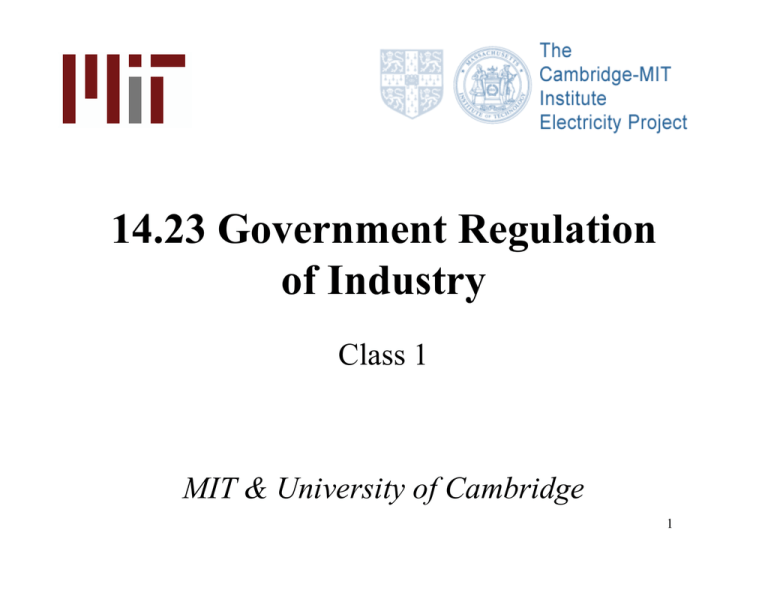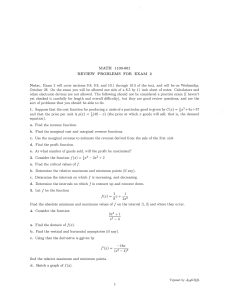Document 13572865
advertisement

14.23 Government Regulation of Industry Class 1 MIT & University of Cambridge 1 Outline • • • • • • • Definitions Course Outline Introduction to Social Cost Benefit Analysis Economic Regulation in Practice Costs and Benefits of Regulation What do regulatory agencies do? Concluding Remarks 2 What is Government Regulation€ of Industry?€ • Government regulation of industry is local, federal or state government control of individual or firm behavior via the mechanisms of setting the prices or controlling the quantity and quality of goods and services produced. • E.g. setting rates for electricity service. • E.g. setting quality standards for auto seat belts. 3 Economic and Social Regulation • In this course we differentiate between two types of government regulation: • Economic Regulation – the government control of firm behavior of industries characterized by a lack of competition (traditionally national monopolies). e.g. electricity rates. • Social Regulation – the government control of individual and firm behavior with respect to the environmental and health and safety implications of the production and consumption of goods and services (traditionally externalities). e.g. emissions from power 4 plants. Course Outline and Key Activities • There will be 5 homework assignments. • There will be a mid-term exam in class. • There will be a final exam during the exam period. 5 Key Times and Dates • Class 9-10.30AM. • Recitation -10AM. • First Homework due in Class #7 at 9AM. • Mid Term in Class #13 at 9AM. 6 Outline of Course • Three Main Sections: • I. Revision of Basic Industrial Organization – Especially the implications of departures from perfect competition for social welfare. • II. Economic Regulation – How monopoly power can be mitigated in electricity, telecom, rail, truck and airline sectors. • III. Social Regulation – How economic evaluations can be used in assessing environmental controls, health and safety regulation and patent and copyright issues. 7 Industries Examined • • • • • • • • • • Industry Considered: Electricity Cable Television Wireline Telephony Wireless Telephony Trucks Railways Airlines Pharmaceuticals Internet Music • • • • • • • • • • Regulatory Approach: Price regulation Franchise Auction Price regulation/unbundling Spectrum Auction Price regulation De-regulation De-regulation Patents Copyright 8 General Approach • The recommended textbook is: – Viscusi, K., Vernon, J. and Harrington, J., Economics of Regulation and Anti-Trust, 2000, MIT Press. Referred to as VVH. • This is rather long and overly focused on the US however I will generally follow it. • I will use examples (good and bad) from Europe as well. • I will offer some pointers on the problem sets but will concentrate on concepts and evidence in class. • Marko will help you with the details of approaching the problem sets and the quantitative parts of the course. 9 Government Regulation • Governments regulate private sector behavior by regulations. In economic theory a new regulation should be subject to a general economic test: • Does a proposed regulation maximize the net benefits (i.e.. Benefits minus Costs)? • The calculation of net benefits should be undertaken using social cost benefit analysis. 10 Social Cost-Benefit Analysis Bt − C t = Net Present Value ∑ t i = 0 (1 + r ) where T = Life of project T B t = Project Benefits at time t C t = Project Costs at time t r = social discount rate 11 Social Cost Benefit Analysis • Benefits include the value of savings to consumers in lower prices, the value of extra safety, the value of the health benefits of lower pollutants. • Costs include the costs to regulated companies in complying with the regulation, as well as the direct costs to the regulatory agency of enforcement. • Private and financial net benefits may differ from social net benefits. • Discounting means that higher benefits now make regulation more likely and that changes in the discount rate may render a previously desirable 12 project undesirable. Social Cost Benefit Analysis • A regulatory change produces some benefits and some costs. The issue is whether the net benefits are positive AND whether the a different regulatory change might have produced even more positive effects. • We should go on making changes to regulation until there are no further changes that are possible which produce positive net benefits. • This is a situation when the rate of change of net benefit with respect to changing regulation is zero. • The social marginal cost and social marginal 13 benefit of changing regulations are equal. Marginal Social Costs and Marginal Social Benefits $ SMC S*=Optimal Strength of Regulation 10 0 SMB S* Strength of Regulation (e.g. Safety Standard of seat belt) 14 Practical Complications • Of course it is not as easy as the calculations appear in practice to put in place the regulations that are best for society. • Political constituencies mean divergence between constituency interests and society’s interests. • Budget constraints mean if net social benefits imply net budget costs they may not be funded. • Incentives to reduce regulation are poor in regulatory agencies. • Capture of regulatory agencies by the companies they regulate is likely if regulatory agency and companies co-exist over a long time. • Inability of governments to solve complex regulatory problems may mean they may not be able to implement the best solution. 15 Regulation in Practice • Stylized way regulation is implemented: • Government appoints a regulatory agency with a mandate to achieve certain objectives. • The regulatory agency then has discretion within its mandate to set regulations which are consistent with its mandate. • In both the US and the European Union regulation is complicated by overlapping regulatory jurisdictions: local, state and federal agencies may regulate aspects of the same type of behavior e.g. health and safety legislation. 16 Process of Oversight in the US • New proposals for federal regulations from regulatory agencies must be approved by the Office of Management and Budget (OMB), an executive agency. • The OMB via its unit the Office of Information and Regulatory Affairs (OIRA) applies cost benefit analysis to new regulations before approving them. • It can negotiate with the agency concerned over amendments and reject changes outright. • Once approved changes are formally published in 17 the Federal Register. Regulations under Clinton and Bush • Clinton passed an executive order which substantially reduced the incidence of OMB interference in regulatory agencies. • Bush has aimed to reduce the number of new rules coming from regulatory agencies via stiffer costbenefit tests. • During 2001 there was a 5% reduction in the number of new rules. • However the cost (not the benefit) of regulation in the US was $854bn or 8.4% of GDP in 2001 (environmental, price controls and paperwork). 18 Costs and Benefits of Regulation Source: Crews, 2002. 19 Benefits of De-regulation • De-regulation usually refers to attempts to reduce entry barriers to industries and the reduction of controls on prices in order to stimulate greater competition. However effective de-regulation usually involves some ‘re-regulation’. • The hoped for advantages are: • Lower Prices • Lower Costs • More choice 20 What do regulators maximize? • • • • • The sum of the net social benefits. The size of their budgets and influence. The career prospects of their employees. The welfare of their employees. Nothing. 21 Conclusions • Government Regulation of Industry involves economic and social regulation of firm and individual behavior. • Such regulation should be based on social cost benefit analysis coupled with the equating of marginal social costs and benefits of regulation. • In practice regulation often seems excessive and this feeling has led to some significant moves towards de-regulation in recent years. 22 Next • Revision of Different Types of Markets. • Read VVH Chapter 4. 23








